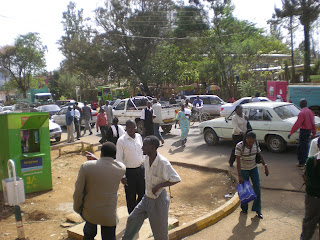





Why are we in Eldoret? Eldoret is where the Moi Teaching & Referral Hospital is located. Indiana University as been supporting Moi University and hospital with funds, equipment, and human resources since the early 80's (www.iukenya.org). We started our trip by going on safari because we arrived on the weekend and hoped doing so would help us adjust to the 8 hour time difference before going to work.
Our first full day in Eldoret was spent mostly at the hospital but we also walked into downtown in the late afternoon to check things out. Our traveling party includes Susan and Kyle, Dr. Adam Cohen (plastic surgeon), Donna Porter (ICU nurse), Dr. David Mathews (general surgeon and our leader), and Noah Mathews (12 year old son of Dave).
Today we mostly met up with our counterparts in their specialties. (Kyle was paired with the chief engineer at the hospital and Noah hung around with his dad.)
Dave Mathews and family lived and worked here for 5 years, moving back to Indy around 6 years ago. He still comes back quite regularly to help out. There are many IU faculty that come here to work on a short or long term basis. There are also medical students and residents that come here for rotations. This is the first time that specialists, like ENT & Plastics, have come to Eldoret. We are staying at the IU "compound" which is a grouping of doubles that house all these people for a small fee. Most meals are provided and basic needs are cared for. It is within walking distance of the hospital.
Susan worked some in the ENT clinic today and will help with a large surgery on Thursday if they can get enough donated blood to perform the surgery. The hospital is very busy and crowded. There were people sitting and standing everywhere. On the wards we were on today, there were beds in areas not meant for beds, the beds are within arm's reach of each other, and most patients have to share a bed (this is a cot-like, twin size bed, imagine that with two grown men in it!). Even on our first day, it is clear that the pathology present here is incredible. Every clinic patient had significant disease, including a twenty two year old new mother with stage IV nasopharynx cancer. We then saw a ward patient with a face/neck mass that had been present for eight years and is now almost the size of a volleyball.
Many of our blog readers may not know that Susan worked in Kenya for over 2 months at the end of her med school training (a number of years ago.) She worked in a small village (not a large city like this) which was much further out in a very rural area. The clinic she worked at was much more primitive. She has always wanted to come back to do some work in Kenya again!
Downtown Eldoret is busy, crowded, noisy, smelly (mostly from wood fires), and did I mention crowded? We walked into downtown late in the afternoon and tried to get some cash from some ATM's, but none would dispense. Must be a network problem. I'm guessing this is not too unusual here. We walked through the open market area where many different things are sold, including fresh fruits and vegetables, dried smoked fish, used shoes, new clothes, electronics, and who knows what else!
Tomorrow we'll spend the whole day at the hospital.
p.s. happy birthday Seth!


















































